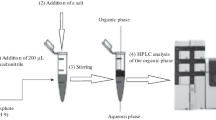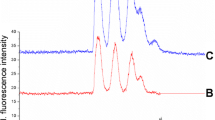Abstract
Analytical microextraction techniques, including solid-phase microextraction (SPME) Arthur & Pawliszyn (Anal Chem 62:2145–2148, 1990), stir bar sorptive extraction (SBSE), Baltussen et al. (J Microcol 11:737–747, 1999), single-drop microextraction (SDME) Jeannot & Cantwell (Anal Chem 68:2236–2240, 1996), hollow-fiber liquid-phase microextraction (HF-LPME) Pedersen-Bjergaard & Rasmussen (Anal Chem 71:2650–2656, 1999), dispersive liquid-liquid microextraction (DLLME) Berijani et al (J Chromatogr A. 1123:1–9, 2006), and electromembrane extraction (EME) Pedersen-Bjergaard & Rasmussen (J Chromatogr A 1109:183–190, 2006) have gained considerable interest in recent years. The latter technique, EME, differs from the others by the fact that mass transfer and extraction is facilitated by electrokinetic migration. Thus, basic or acidic analytes are extracted in their ionized form from aqueous sample, through an organic supported liquid membrane (SLM) and into an aqueous acceptor solution under the influence of an electrical potential. EME provides pre-concentration and sample clean-up, and can be performed in 96-well format using only a few microliter organic solvent per sample (green chemistry). Extraction selectivity is controlled by the direction and magnitude of the electrical field, by the chemical composition of the SLM, and by pH in the acceptor solution and sample. This trends article discusses briefly the principle, performance, and current status of EME, and from this future directions and perspectives are identified. Unlike traditional extraction methods, EME involves electrokinetic transfer of charged analyte molecules across an organic phase (SLM) immiscible with water. This process is still not fully characterized from a fundamental point of view, and more research in this area is expected in the near future. From author’s point of view, such research at the interface between electrophoresis and partition will be highly important for future implementation of EME.

Graphical abstract



Similar content being viewed by others
References
Pedersen-Bjergaard S, Rasmussen KE. Liquid-liquid-liquid microextraction for sample preparation of biological fluids prior to capillary electrophoresis. Anal Chem. 1999;71:2650–6.
Pedersen-Bjergaard S, Rasmussen KE. Electrokinetic migration across artificial liquid membranes: new concept for rapid sample preparation of biological fluids. J Chromatogr A. 2006;1109:183–90.
Vårdal L, Øiestad EL, Gjelstad A, Pedersen-Bjergaard S. Electromembrane extraction of substances with weakly basic properties: a fundamental study with benzodiazepines. Bioanalysis. 2018;10:769–81.
Nakamura M. Analyses of benzodiazepines and their metabolites in various biological matrices by LC-MS(/MS). Biomed Chromatogr. 2011;25:1283–307.
Huang C, Chen Z, Gjelstad A, Pedersen-Bjergaard S, Shen X. Electromembrane extraction. Trends Anal Chem. 2017;95:47–56.
Pedersen-Bjergaard S, Huang C, Gjelstad A. Electromembrane extraction - recent trends and where to go. J Pharm Anal. 2017;7:141–7.
Wuethrich A, Haddad PR, Quirino JP. The electric field – an emerging driver in sample preparation. Trends Anal Chem. 2016;80:604–11.
Oedit A, Ramautar R, Hankemeier T, Lindenburg PW. Electroextraction and electromembrane extraction: advances in hyphenation to analytical techniques. Electrophoresis. 2016;37:1170–86.
Rezazadeh M, Yamini Y, Seidi S. Electrically stimulated liquid-based extraction techniques in bioanalysis. Bioanalysis. 2016;8:815–28.
Ramos Payan M, Santigosa E, Fernandez Torres R, Bello Lopez MA. A new micro-chip design. A versatile combination of electromembrane extraction and liquid-phase microextraction in a single chip device. Anal Chem. 2018;90:10417–24.
Drouin N, Mandscheff J-F, Rudaz S, Schappler J. Development of a new extraction device based on parallel-electromembrane extraction. Anal Chem. 2017;89:6346–50.
Tahmasebi Z, Davarani SSH, Ebrahimzadeh H, Asgharinezhad AA. Ultra-trace determination of Cr (VI) ions in real water samples after electromembrane extraction through novel nanostructured polyaniline reinforced hollow fibers followed by electrothermal atomic absorption spectrometry. Microchem J. 2018;143:212–9.
Slampova A, Sindelar V, Kuban P. Application of a macrocyclic compound, bambus[6]uril, in tailor-made liquid membranes for highly selective electromembrane extractions of inorganic anions. Anal Chim Acta. 2017;950:49–56.
Ara KM, Raofie F, Seidi S. Simultaneous extraction and determination of trace amounts of olanzapine and fluoxetine from biological fluids: comparison of conventional hollow fiber supported liquid phase microextraction and pulsed electrically assisted liquid-phase microextraction techniques. Anal Methods. 2015;7:7840–51.
Roman-Hidalgo C, Maria Jesus M-V, Fernandez-Torres R, Bello-Lopez MA. Use of polymer inclusion membranes (PIMs) as support for electromembrane extraction of non-steroidal anti-inflammatory drugs and highly polar acidic drugs. Talanta. 2018;179:601–7.
Sedehi S, Tabani H, Nojavan S. Electro-driven extraction of polar compounds using agarose gel as new membrane. Determination of amino acids in fruit juice and human plasma samples. Talanta. 2018;179:318–25.
Huang C, Gjelstad A, Pedersen-Bjergaard S. Selective electromembrane extraction based on isoelectric point: fundamental studies with angiotensin II antipeptide as model analyte. JMembrane Sci. 2015;481:115–23.
Seip KF, Jensen H, Sønsteby MH, Gjelstad A, Pedersen-Bjergaard S. Electromembrane extraction: distribution or electrophoresis? Electrophoresis. 2013;34:792–9.
Sun J-N, Shi Y-P, Chen J. Development of ionic liquid based electromembrane extraction and its application to the enrichment of acidic compounds in pig kidney tissues. RSC Adv. 2015;47:37682–90.
Hasheminasab KS, Fakhari AR. Development and application of carbon nanotubes assisted electromembrane extraction (CNTs/EME) for the determination of buprenorphine as a model of basic drugs in urine samples. Anal Chim Acta. 2013;767:75–80.
Ramos-Payán M, Fernández-Torres R, Pérez-Bernal JL, Callejón-Mochón M, Bello-López MT. A novel approach for electromembrane extraction based on the use of silver nanometallic-decorated hollow fibers. Anal Chim Acta. 2014;849:7–11.
Huang C, Gjelstad A, Pedersen-Bjergaard S. Organic solvents in electromembrane extraction: recent insights. Rev Anal Chem. 2016;35:169–83.
Huang C, Gjelstad A, Pedersen-Bjergaard S. Electromembrane extraction with alkylated phosphites and phosphates as supported liquid membranes. J Membrane Sci. 2017;526:18–24.
Huang C, Gjelstad A, Seip KF, Jensen H, Pedersen-Bjergaard S. Exhaustive and stable electromembrane extraction of acidic drugs from human plasma. J Chromatogra A. 2015;1425:81–7.
Drouin N, Rudaz S, Schappler J. New supported liquid membrane for electromembrane extraction of polar basic endogenous metabolites. J Pharm and Biomed Anal. 2018;159:53–9.
Seip KF, Stigsson J, Gjelstad A, Balchen M, Pedersen-Bjergaard S. Electromembrane extraction of peptides - fundamental studies on the supported liquid membrane. J Sep Sci. 2011;34:3410–7.
Dominguez NC, Gjelstad A, Nadal AM, Jensen H, Petersen NJ, Honoré Hansen S, et al. Selective electromembrane extraction at low voltages based on analyte polarity and charge. J Chromatogra A. 2012;1248:48–54.
Restan MS, Jensen H, Shen X, Huang C, Martinsen ØG, Kuban P, et al. Comprehensive study of buffer systems and local pH effects in electromembrane extraction. Anal Chim Acta. 2017;984:116–23.
Lin B, Wan L, Sun X, Huang C, Pedersen-Bjergaard S, Shen X. Electromembrane extraction of high level substances: a novel approach for selective recovery of templates in molecular imprinting. J Membrane Sci. 2018;568:30–9.
Hansen FA, Sticker D, Kutter JP, Petersen NJ, Pedersen-Bjergaard S. Nanoliter-scale electromembrane extraction and enrichment in a microfluidic chip. Anal Chem. 2018;90:9322–9.
Zarghampour F, Yamini Y, Baharfar M, Faraji M. Electromembrane extraction of biogenic amines in food samples by a microfluidic-chip system followed by dabsyl derivatization prior to high performance liquid chromatography analysis. J Chromatogr A. 2018;1556:21–8.
Baharfar M, Yamini Y, Seidi S, Arain MB. Approach for downscaling of electromembrane extraction as a lab on-a-chip device followed by sensitive red-green-blue detection. Anal Chem. 2018;90:8478–86.
Arthur CL, Pawliszyn J. Solid phase microextraction with thermal desorption using fused silica optical fibers. Anal Che. 1990;62:2145–8.
Baltussen E, Sandra P, David F, Cramels C. Stir bar sorptive extraction (SBSE), a novel extraction technique for aqueous samples: theory and principles. J Microcol Sep. 1999;11:737–47.
Jeannot MA, Cantwell FF. Solvent microextraction into a single drop. Anal Chem. 1996;68:2236–40.
Berijani S, Assadi Y, Anbia M, Milani Hosseini MR, Aghaee E. Dispersive liquid-liquid microextraction combined with gas chromatography-flame photometric detection. Very simple, rapid and sensitive method for the determination of organophosphorus pesticides in water. J Chromatogr A. 2006;1123:1–9.
Author information
Authors and Affiliations
Corresponding author
Ethics declarations
Conflict of interest
The author declares that there are no conflicts of interest.
Additional information
Publisher’s Note
Springer Nature remains neutral with regard to jurisdictional claims in published maps and institutional affiliations.
Rights and permissions
About this article
Cite this article
Pedersen-Bjergaard, S. Electromembrane extraction—looking into the future. Anal Bioanal Chem 411, 1687–1693 (2019). https://doi.org/10.1007/s00216-018-1512-x
Received:
Revised:
Accepted:
Published:
Issue Date:
DOI: https://doi.org/10.1007/s00216-018-1512-x




